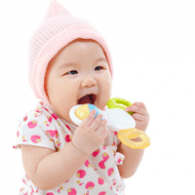What Teething Looks Like
Your beautiful five-month-old baby boy, who has been the most perfect little angel since birth, has suddenly turned into a cranky, fussy, drooling, chews-on- everything-in-site little monster! He is now keeping you up half the night, and needs to be held, bounced, and nursed all day long.
Welcome to the wonderful world of teething! Here are some practical tips to help you and your baby get through this growing stage:
5 signs your baby is teething
- Bulging gums – you can actually see the outline of the teeth as they are bulging inside the gums. The middle bottom teeth are usually the first place this happens.
- Drooling – it will seem like someone left a “drool faucet” on inside your baby’s mouth.
- Fussing – your baby will often become cranky and more difficult to console.
- Biting – your baby will start chewing on everything he can get his hands, or gums, on – his fingers, your fingers, toys, and especially the breast.
- Night waking – most babies sleep fairly well between one and four months of age, but now the honeymoon is over! Beginning around four months of age, baby may start waking up much more frequently at night.
Remedies for teething
Anything cold
Here are a variety of cool favorites:
- Frozen teething rings
- Ice – rub an ice cube along baby’s gums.
- Frozen juice slushy or Popsicle
- Cold spoons
- Frozen bagel or banana
- Frozen washcloth
Medications
- Acetaminophen or Ibuprofen (Click on these for dosing)– these are both safe and effective pain relievers to help your baby, and you, get some sleep during the teething stage.
- Teething gels– there are various over-the-counter gels, pastes, or liquids that numb the gums. Pat the gums dry with a washcloth, then apply a small amount only on the area of the gums that is bulging. There are several drawbacks to these, so we suggest you only use them as a last resort because:
- They taste terrible
- They travel throughout the mouth in the saliva and can numb the tongue and lips
- It is easy to use too much
- Baby may swallow too much
4 teething symptoms that are harmless
There are several symptoms most babies exhibit during teething. DON’T WORRY. These are only temporary and normal.
- Drool rash – your baby may get a red, raised rash on the face, lips, chin, neck, and chest. Gently wash with warm water and pat dry. A lanolin ointment is a good treatment.
- Diarrhea – this is generally mild and does not require any special treatment.
- Fever– baby may experience low-grade fevers less than 101. If your baby has a fever higher than this, click on fever for more info.
- Cough – the abundance of saliva often drips down baby’s throat and can cause coughing or gagging.
Dr. Sears, or Dr. Bill as his “little patients” call him, has been advising busy parents on how to raise healthier families for over 40 years. He received his medical training at Harvard Medical School’s Children’s Hospital in Boston and The Hospital for Sick Children in Toronto, the world’s largest children’s hospital, where he was associate ward chief of the newborn intensive care unit before serving as the chief of pediatrics at Toronto Western Hospital, a teaching hospital of the University of Toronto. He has served as a professor of pediatrics at the University of Toronto, University of South Carolina, University of Southern California School of Medicine, and University of California: Irvine. As a father of 8 children, he coached Little League sports for 20 years, and together with his wife Martha has written more than 40 best-selling books and countless articles on nutrition, parenting, and healthy aging. He serves as a health consultant for magazines, TV, radio and other media, and his AskDrSears.com website is one of the most popular health and parenting sites. Dr. Sears has appeared on over 100 television programs, including 20/20, Good Morning America, Oprah, Today, The View, and Dr. Phil, and was featured on the cover of TIME Magazine in May 2012. He is noted for his science-made-simple-and-fun approach to family health.

